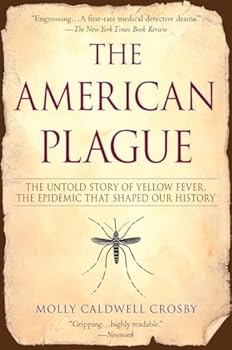The American Plague: The Untold Story of Yellow Fever, The Epidemic That Shaped Our History
Select Format
Select Condition 
Book Overview
In this account, a journalist traces the course of the infectious disease known as yellow fever, "vividly evoking] the Faulkner-meets-Dawn of the Dead horrors" (The New York Times Book Review) of this... This description may be from another edition of this product.
Format:Paperback
Language:English
ISBN:0425217752
Release Date:September 2007
Publisher:Berkley
Length:400 Pages
Weight:0.86 lbs.
Dimensions:8.2" x 1.1" x 5.5"
Customer Reviews
5 ratings
Fascinating, sometimes shocking, page turner
Published by Jennywithlime , 2 years ago
I’ve read it twice and love it. I feel like I’m right there, unknowing yet terrified, with the rest of them. Fantastic story telling combined with actual histories so I am thoroughly entertained while feeling the thrill of learning something.
Well researched and nicely put together
Published by Thriftbooks.com User , 17 years ago
This is a very good book. More than dates and events, the author descibes the often confused efforts to understand this nasty disease. Also, without much hyperbole, you get to see the amazing heroism of the volunteers and doctors on Walter Reed's team. This is not a virology textbook, but mostly the science part is accurate, if too descriptive at times. The story of the Memphis epidemic is very-very good: find out how impossible it is to control an epidemic when no one understands the disease. I would highly recommend this book to anyone interested in the history of medicine.
History, science and public health issues blend in a lively writing style
Published by Thriftbooks.com User , 17 years ago
THE AMERICAN PLAGUE: THE UNTOLD STORY OF YELLOW FEVER, THE EPIDEMIC THAT SHAPED OUR HISTORY tells of a virus so destructive that one outbreak cost more lives than the Chicago Fire, the San Francisco Earthquake and the Johnstown flood combined. THE AMERICAN PLAGUE narrows the focus to Memphis' near destruction from the epidemic, and the researchers who battled to find a cure and prevention tactics. History, science and public health issues blend in a lively writing style which lends to acquisition not only by college-level holdings strong in the health sciences, but by public institutions with leisure browsers in health history. Diane C. Donovan California Bookwatch
American Plague
Published by Thriftbooks.com User , 17 years ago
It kept my interest from start to finish. I found myself reading certain chapters over a second time to digest some of the information. I especially enjoyed the mini biography of Walter Reed.
The Incomplete Victory over Yellow Fever
Published by Thriftbooks.com User , 18 years ago
For as long as we have had illnesses, we have tried to understand them; the earliest of understandings was that some angry deity was sending down punishment for some sort of transgression. It's an explanation that still satisfies many people. Yellow fever could be seen as vengeance direct from God. It was a disease spawned in Africa, and Europeans involved in the slave trade were especially stricken. There is no reason that a yellow fever epidemic has never infested Asia, except that there was no African slave trade there. It infested all of the American colonies, but when the Atlantic slave trade was abolished in the northern states, it went away, continuing in the southern ones. Gods were not involved in the illness, however, or at least their involvement is less direct than the virus that causes the dreadful symptoms and death, or the mosquito that carries the virus. In _The American Plague: The Untold Story of Yellow Fever, the Epidemic That Shaped Our History_ (Berkley), Molly Caldwell Crosby details the ravages of the epidemics, the process by which the disease was brought under some control, and the fears that it might again become a player on the world's pathology stage. Crosby lives in Memphis, and the first part of her book tells of the epidemic there of 1878. The passages describing the disease within the city's neighborhoods are a combination of Faulkner and Poe. The disease sounds dreadful. The disease had come to Memphis from Havana, borne by the steamer _Emily B. Souder_ up the Mississippi, and starting in July 1878, Memphis residents began dropping; it is a dismal and scary tale. The second half of Crosby's book tells the more familiar story of the eventual understanding of how the disease worked. Walter Reed and his fellow investigators managed to overcome the irrational resistance of doctors that mosquitoes could bear the illness, doing so by starkly effective experiments. There was one ward, the Infected Clothing Building, where the three unfortunate inhabitants would be sealed in along with the detritus of patients who had had the disease, including clothes and sheets soiled with sweat, vomit, and feces. They used those very clothes and sheets, but still, theirs was the experimental group that was safer; none of them came down with the illness. That was not so in the Infected Mosquito Building; fortunately for Reed's work, the inhabitants became deathly ill with yellow fever, but were nursed back to health. Knowing that the mosquito bears the virus allowed the prevention programs that killed mosquitoes and eliminated standing water where the larvae and eggs grow. These were admirable and effective measures. We know now the virus that causes the illness, and we have a vaccine for it. The use of the vaccine has fallen off, however, and yellow fever is making new inroads in Africa. Crosby makes the point that although we don't have steamers like the _Souder_ anymore, container ships and airplanes are effectiv






